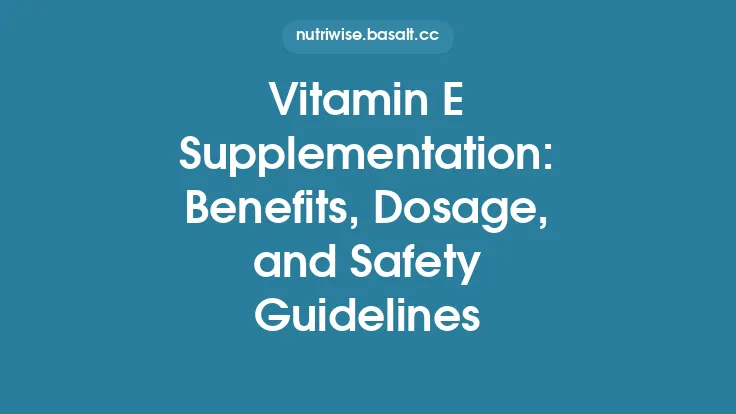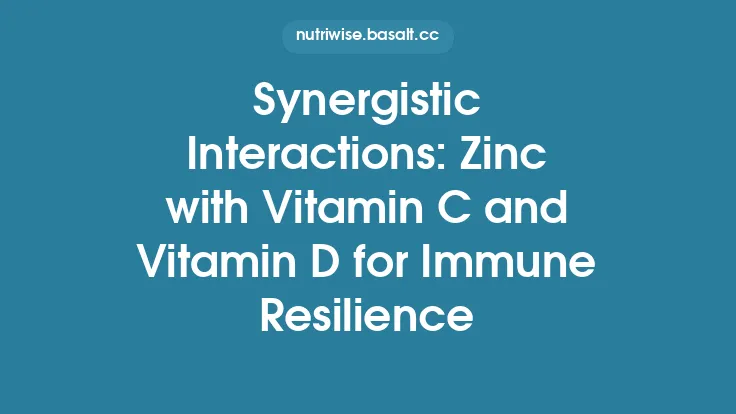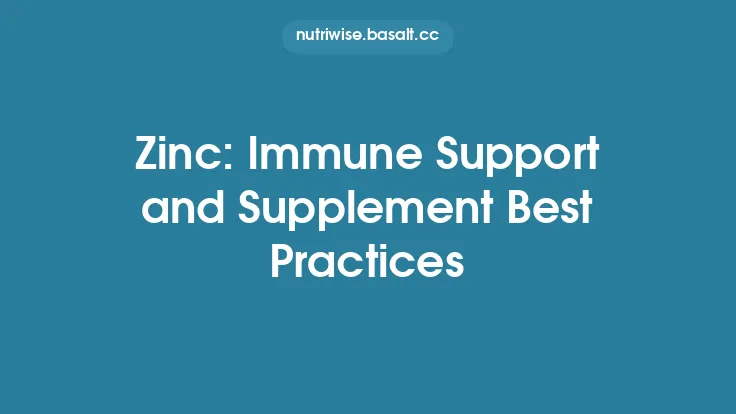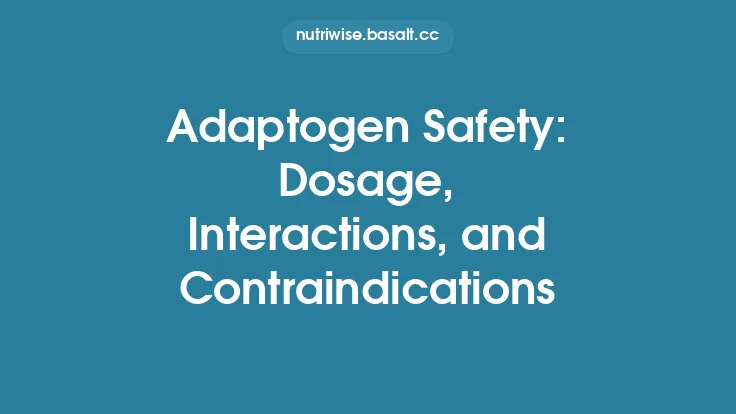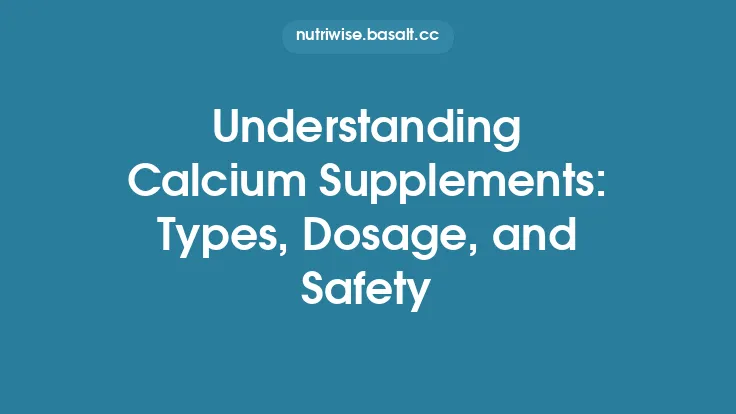Zinc is one of the most widely studied trace minerals when it comes to supporting the body’s defensive mechanisms. While a balanced diet can usually provide sufficient amounts, many individuals turn to supplementation to ensure that their immune system has the zinc it needs, especially during periods of heightened stress, illness, or increased physiological demand. This article delves into the practical aspects of zinc supplementation: how much to take, which forms are most effective, how to avoid adverse effects, and what safety checks are advisable for a responsible, evidence‑based approach to immune wellness.
Understanding Supplement Forms and Bioavailability
Not all zinc supplements are created equal. The mineral can be delivered in a variety of chemical complexes, each with distinct absorption characteristics and tolerability profiles.
| Form | Typical Elemental Zinc Content (per 50 mg dose) | Relative Bioavailability* | Common Uses |
|---|---|---|---|
| Zinc gluconate | ~14 mg | Moderate | General supplementation |
| Zinc sulfate | ~22 mg | High (but can be harsh on the stomach) | Clinical settings, acute repletion |
| Zinc acetate | ~15 mg | High | Cold‑duration studies |
| Zinc picolinate | ~15 mg | Very high (chelated) | Athletes, high‑absorption needs |
| Zinc methionine (Zn‑Met) | ~15 mg | Very high (amino‑acid chelate) | Sensitive gastrointestinal tracts |
| Zinc citrate | ~15 mg | Moderate‑high | Food‑fortified products |
| Zinc oxide | ~30 mg | Low (poorly soluble) | Topical preparations, some multivitamins |
\*Relative bioavailability is based on comparative fractional absorption studies in healthy adults.
Key take‑aways
- Chelated forms (picolinate, methionine) tend to be the most efficiently absorbed, especially when taken on an empty stomach.
- Inorganic salts (sulfate, acetate) are also well absorbed but may cause nausea or gastric irritation in some users.
- Zinc oxide is inexpensive but has the lowest absorption; it is rarely recommended for systemic immune support.
Choosing a form that aligns with personal tolerance and absorption goals can reduce the need for higher doses, thereby lowering the risk of toxicity.
Evidence‑Based Dosage Ranges for Immune Support
The optimal supplemental dose for immune wellness is a balance between achieving a therapeutic effect and staying within safety margins. Clinical trials and meta‑analyses provide a practical window:
| Population | Typical Supplemental Dose (Elemental Zn) | Frequency | Duration of Use |
|---|---|---|---|
| Healthy adults (maintenance) | 15–30 mg/day | Once daily | Ongoing, with periodic breaks |
| Adults under acute stress (e.g., travel, intense training) | 30–45 mg/day | Once daily | 4–8 weeks, then reassess |
| Older adults (≥65 y) with reduced absorption | 20–30 mg/day | Once daily | Continuous, monitor serum Zn |
| Individuals recovering from a viral infection | 30–50 mg/day (split dose) | 2–3 times/day | 2–3 weeks, then taper |
| Pregnant or lactating women | 15–25 mg/day (under medical supervision) | Once daily | Throughout pregnancy/lactation |
Why the range matters
- Below 15 mg/day: Most dietary intake already meets this level; additional supplementation offers limited incremental benefit for immune parameters.
- 15–30 mg/day: Consistently shown to improve markers such as NK‑cell activity and cytokine balance without raising serum copper or causing gastrointestinal upset in the majority of participants.
- 30–50 mg/day: May be justified during short‑term immune challenges (e.g., cold season, high‑intensity training) but requires monitoring for adverse effects, especially in individuals with pre‑existing renal or hepatic conditions.
It is essential to remember that the Recommended Dietary Allowance (RDA) for zinc is 11 mg for adult men and 8 mg for adult women. Supplementation should be viewed as an addition to, not a replacement for, dietary intake.
Timing and Frequency: Optimizing Absorption
Zinc absorption is influenced by the presence of competing minerals and the state of the gastrointestinal tract.
- Empty‑stomach dosing (30 minutes before a meal or 2 hours after) maximizes fractional absorption, particularly for chelated forms.
- Food‑based dosing can reduce gastrointestinal irritation, especially with sulfate or acetate salts, but may lower absorption by 20–30 % due to phytates, calcium, and iron.
- Divided doses (e.g., 15 mg twice daily) are advisable when total daily intake exceeds 30 mg, as the intestinal transporters become saturated at ~10–15 mg per dose.
- Avoid concurrent high‑dose iron or calcium supplements within the same 2‑hour window; these minerals compete for the same transport pathways (DMT1 and ZIP4).
A practical schedule for a 30 mg/day regimen could be:
- Morning: 15 mg zinc picolinate on an empty stomach.
- Evening: 15 mg zinc picolinate with a light snack (if stomach sensitivity is an issue).
Upper Intake Levels and Toxicity Risks
The Tolerable Upper Intake Level (UL) for zinc is set at 40 mg/day for adults. Exceeding this threshold over prolonged periods can lead to:
| Toxicity Manifestation | Typical Onset | Mechanism |
|---|---|---|
| Copper deficiency | 6–12 months of excess | Zinc induces metallothionein in enterocytes, which preferentially binds copper, reducing its absorption. |
| Altered lipid profile | 3–6 months | High zinc can increase LDL‑cholesterol and lower HDL‑cholesterol in some individuals. |
| Gastrointestinal distress | Immediate | Direct mucosal irritation, especially with inorganic salts. |
| Neurological symptoms (headache, lethargy) | Variable | Rare, associated with severe hyperzincemia (>200 µg/dL). |
| Impaired immune function | Paradoxically, with chronic excess | Dysregulated cytokine production and reduced thymic output. |
Acute toxicity (single dose > 200 mg) can cause nausea, vomiting, abdominal cramps, and, in extreme cases, renal failure. Prompt medical evaluation is required.
Special Considerations for Vulnerable Populations
| Group | Adjusted Guidance | Rationale |
|---|---|---|
| Children (1–12 y) | 5–10 mg/day (max 20 mg) under pediatric supervision | Rapid growth demands zinc, but the margin for excess is narrow. |
| Elderly (≥65 y) | 20–30 mg/day, preferably chelated | Age‑related decline in gastric acidity reduces absorption of inorganic salts. |
| Pregnant/Lactating Women | 15–25 mg/day, only if dietary intake is insufficient | Fetal development and milk production increase zinc turnover; however, excess can affect fetal copper status. |
| Individuals with Chronic Kidney Disease (CKD) | 10–15 mg/day, monitor serum zinc quarterly | Impaired renal excretion may lead to accumulation; also, CKD patients often have altered mineral metabolism. |
| Patients on diuretics (e.g., thiazides) | 10–20 mg/day, assess urinary zinc loss | Diuretics increase urinary zinc excretion, potentially necessitating modest supplementation. |
In all cases, a baseline serum zinc measurement (optimal range 70–120 µg/dL) is advisable before initiating supplementation, followed by periodic reassessment.
Potential Drug–Supplement Interactions
| Medication | Interaction Mechanism | Clinical Implication |
|---|---|---|
| Antibiotics (tetracyclines, fluoroquinolones) | Chelation in the gut reduces absorption of both agents | Separate dosing by at least 2 hours. |
| Penicillamine | Forms insoluble complexes with zinc, decreasing its bioavailability | Monitor zinc status; consider alternative chelators. |
| ACE inhibitors (e.g., enalapril) | May increase zinc loss via urine | Periodic zinc level checks recommended. |
| Thyroid hormone replacement (levothyroxine) | Zinc can interfere with absorption | Administer levothyroxine on an empty stomach, zinc at a different time of day. |
| Copper supplements | Competitive absorption; high zinc can precipitate copper deficiency | Maintain a balanced copper‑to‑zinc ratio (≈0.7:1) if both are supplemented. |
Healthcare providers should review a patient’s full medication list before recommending zinc supplementation, especially at doses approaching the UL.
Monitoring and Adjusting Your Regimen
A systematic approach to safety involves baseline and follow‑up assessments:
- Baseline Evaluation
- Serum zinc concentration (fasting sample).
- Copper level (to detect pre‑existing imbalance).
- Complete blood count (CBC) and lipid panel (for baseline metabolic status).
- Follow‑Up (3–6 months)
- Repeat serum zinc; aim for 80–110 µg/dL.
- Re‑measure copper if zinc > 30 mg/day.
- Assess gastrointestinal tolerance and any new symptoms.
- Adjustment Criteria
- If serum zinc is within target and no adverse effects: Continue current dose.
- If zinc exceeds 120 µg/dL or copper drops below 80 µg/dL: Reduce dose by 5–10 mg or switch to a lower‑absorption form (e.g., zinc gluconate).
- If gastrointestinal upset persists: Switch to a chelated form or take with a small meal.
Self‑monitoring tools such as symptom diaries can help correlate dosage changes with perceived immune wellness (e.g., frequency of colds, recovery time from minor infections).
Practical Tips for Safe Supplement Use
- Start low, go slow. Begin with the lowest effective dose (often 15 mg/day) and titrate upward only if needed.
- Choose reputable brands. Look for third‑party testing (USP, NSF) to ensure label accuracy and absence of contaminants like lead or cadmium.
- Store properly. Keep supplements in a cool, dry place; moisture can degrade certain zinc salts.
- Avoid mega‑doses for “quick fixes.” High‑dose “immune‑boosting” regimens marketed during outbreaks often exceed the UL and lack robust evidence.
- Integrate with diet, not replace it. Even when supplementing, maintain a balanced intake of other micronutrients (vitamins A, C, D, selenium) that synergistically support immunity.
- Consult a professional. Individuals with chronic illnesses, pregnant women, and children should obtain medical guidance before initiating any zinc supplement regimen.
By adhering to evidence‑based dosage guidelines, selecting appropriate supplement forms, and implementing vigilant safety checks, zinc can be a reliable ally in maintaining robust immune function without compromising overall health. The key lies in personalized dosing, regular monitoring, and an informed approach that respects both the potency of the mineral and the body’s intricate balance of trace elements.
